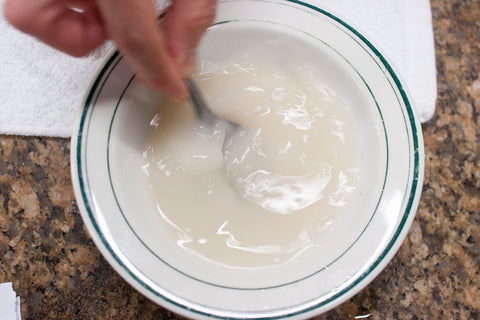Great pizza starts with the right dough. Brian, our wholesale manager, has spent countless hours developing his special dough recipe and has been kind enough to share his secrets. Featuring Caputo 00 Flour, Brian’s dough provides the perfect canvas for any pizza.
From the dough, to the sauce and the toppings, shop all of Ditalia's Pizza Essentials Here!
INGREDIENTS
250 grams Caputo 00 Flour (about 2 cups)
1/4 cup warm water
1/2 cup cool water
1/4 tsp Active Dry Yeast
1 tsp Fine Sea Salt
1/2 tsp Granulated Sugar
PREPARATION

Dissolve the yeast in warm water with the sugar. In a standing mixer bowl, add the cool water and dissolved yeast.

With the mixer on slow speed, using the paddle blade, add about 1/3 or so of the Caputo 00 flour and mix (increasing the speed) for a minute or two, until a smooth “batter” forms. This helps to develop the gluten in the dough.

Add remaining Caputo 00 flour and salt. Once the dough comes together, switch to a dough hook and use a slow/med speed to kneed the dough for 8-10 minutes.
First Proofing
Form dough into a ball and transfer to a bowl lightly oiled with extra virgin olive oil and cover with plastic wrap until rested and has slightly grown in size (approx 1.5 hours). Since very little yeast is used, the dough shouldn’t double in size, as is common for bread recipes.

Second Proofing
Remove dough from bowl and portion into two dough balls. Place on floured sheet pan, cover well with plastic wrap and a towel to make a tight seal, and refrigerate for 24 hours.

Remove dough balls from fridge 1.5 hours prior to making pizza. This allows the dough to reach room temperature, making it more workable.
HELPFUL TIPS
An alternative / quicker method is to forgo the 2nd long proof in the fridge and instead proof the dough the 2nd time at room temp (approximately 4 hours) Care must be taken so that the dough balls do not over proof (ie more than double in size). If it appears the dough would be ready too soon, it can simply be put in fridge to slow down the growing dough a bit. The goal is to have the dough “rise” in the oven – and making sure the dough doesn’t “over proof” is key!
The longer (refrigerated) second proofing yields a more favorable crust that tastes less “yeasty” & is definitely worth the extra preparation day.
The sugar simply helps with the browning of the crust in a conventional oven that tops out at about 500 degrees.
Use a baking stone or baking steel. Preheat oven for an hour at the maximum temperature prior making pizzas.
PIZZA ESSENTIALS

From the dough, to the sauce and the toppings, shop all of Ditalia's Pizza Essentials Here!
46 comments
Just learned about Caputo flour 00, there are different temperature flours, they use blue and red labeling to determine the difference. Would you please elaborate on this, as I heard about it, did not read about it. I heard red is for 500° and blue label flour is for higher temperatures like 900°.
Just learned about Caputo flour 00, the there are different temperature flours they use blue and red labeling to determine the difference. Would you please elaborate on this as I heard about it, did not read about it. I heard red is for 500° and blue label flour is for higher temperatures like 900°.
Just bought a huge 50lb sack of 00 caputo flour yesterday at the Italian centre. I’m going to get busy making some pizza and pasta this week. Wish me luck peeps!
Can’t wait to make this we just made a pizza oven up north
I did this, and ended up with a dough it did not rise and was tough
Viewing 40 of 46